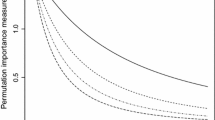Abstract
In many data analysis tasks it is important to understand the relationships between different datasets. Several methods exist for this task but many of them are limited to two datasets and linear relationships. In this paper, we propose a new efficient algorithm, termed cocoreg, for the extraction of variation common to all datasets in a given collection of arbitrary size. cocoreg extends redundancy analysis to more than two datasets, utilizing chains of regression functions to extract the shared variation in the original data space. The algorithm can be used with any linear or non-linear regression function, which makes it robust, straightforward, fast, and easy to implement and use. We empirically demonstrate the efficacy of shared variation extraction using the cocoreg algorithm on five artificial and three real datasets.








Similar content being viewed by others
References
Andrew G, Arora R, Bilmes J, Livescu K (2013) Deep canonical correlation analysis. In: Proceedings of the 30th international conference on machine learning, vol 28, pp 1247–1255
Dähne S, Nikulin VV, Ramírez D, Schreier PJ, Müller KR, Haufe S (2014) Finding brain oscillations with power dependencies in neuroimaging data. NeuroImage 96:334–348
Damianou A, Ek C, Titsias MK, Lawrence ND (2012) Manifold relevance determination. In: Proceedings of the 29th international conference on machine learning, pp 145–152
Fisher J, Darrell T (2003) Speaker association with signal-level audiovisual fusion. IEEE Trans Multimed 6(3):406–413
Hardoon D, Szedmak S, Shawe-Taylor J (2004) Canonical correlation analysis: an overview with application to learning methods. Neural Comput 16(12):2639–2664. doi:10.1162/0899766042321814
Hasson U, Nir Y, Levy I, Fuhrmann G, Malach R (2004) Intersubject synchronization of cortical activity during natural vision. Science 303(5664):1634–1640
Hastie T, Tibshirani R, Friedman J (2003) The elements of statistical learning: data mining, inference, and prediction. Springer, New York
Hotelling H (1936) Relations between two sets of variates. Biometrika 28:321–377
Hsieh WW (2000) Nonlinear canonical correlation analysis by neural networks. Neural Netw 13:1095–1105
Hwang H, Jung K, Takane Y, Woodward TS (2013) A unified approach to multiple-set canonical correlation analysis and principal components analysis. Br J Math Stat Psychol 66(2):308–321. doi:10.1111/j.2044-8317.2012.02052.x
Kettenring J (1971) Canonical analysis of several sets of variables. Biometrika 58:433–451
Klami A, Virtanen S, Kaski S (2013) Bayesian canonical correlation analysis. J Mach Learn Res 14:965–1003
Klami A, Virtanen S, Leppäho E (2015) Group factor analysis. IEEE Trans Neural Netw Learn Syst 26(9):2136–2147. doi:10.1109/TNNLS.2014.2376974
Korpela J, Henelius A (2016) Cocoreg: extracts shared variation in collections of datasets using regression models. http://cran.r-project.org/package=cocoreg
Legendre P, Legendre L (1998) Numerical ecology, 2nd edn. Elsevier, Amsterdam
Liaw A, Wiener M (2002) Classification and regression by randomforest. R News 2(3):18–22. https://cran.r-project.org/package=randomForest
Meyer D, Dimitriadou E, Hornik K, Weingessel A, Leisch F (2014) e1071: misc functions of the department of statistics (e1071), Technische Universität Wien. http://cran.r-project.org/package=e1071
Müller KE (1982) Understanding canonical correlation through the general linear model and principal components. Am Stat 36(4):342–354. doi:10.1080/00031305.1982.10483045
Nguyen HV, Müller E, Vreeken J, Efros P, Böhm K (2014) Multivariate maximal correlation analysis. In: Proceedings of the 31st international conference on machine learning, pp 775–783
R Core Team (2014) R: a language and environment for statistical computing. R Foundation for Statistical Computing, Vienna, http://www.R-project.org/
Tenenhaus A (2011) Regularized generalized canonical correlation analysis and PLS path modeling. Psychometrika 76(2):257–284
Tibshirani R (1996) Regression shrinkage and selection via the lasso. J R Stat Soc Ser B 58(1):267–288
Timmerman ME, Kiers H (2003) Four simultaneous component models for the analysis of multivariate time series from more than one subject to model intraindividual and interindividual differences. Psychometrika 68(1):105–121. doi:10.1007/BF02296656
Virtanen S, Klami A, Khan SA, Kaski S (2012) CCAGFA: Bayesian canonical correlation analysis and group factor analysis. http://cran.r-project.org/package=CCAGFA
Acknowledgments
This work was partly supported by the Revolution of Knowledge Work Project, funded by Tekes (Grants 40228/13 and 5159/31/2014), and in part by Academy of Finland (Finnish Centre of Excellence in Computational Research COIN, 251170; 26696).
Author information
Authors and Affiliations
Corresponding author
Additional information
Responsible editor: Thomas Gärtner, Mirco Nanni, Andrea Passerini and Celine Robardet.
Rights and permissions
About this article
Cite this article
Korpela, J., Henelius, A., Ahonen, L. et al. Using regression makes extraction of shared variation in multiple datasets easy. Data Min Knowl Disc 30, 1112–1133 (2016). https://doi.org/10.1007/s10618-016-0465-y
Received:
Accepted:
Published:
Issue Date:
DOI: https://doi.org/10.1007/s10618-016-0465-y




